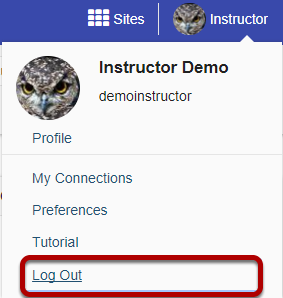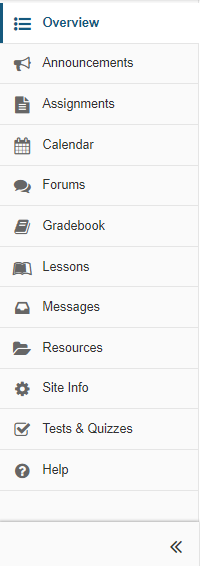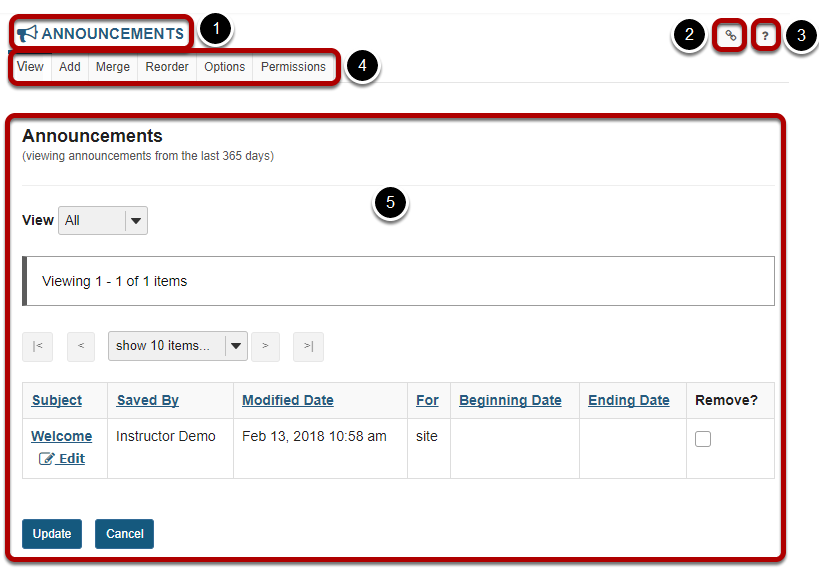Accessibility Information
Sakai is a Learning Management System created to assist faculty and students by providing online tools for communication, assessment, content delivery, etc.
Sakai is composed of sites, and each site has a number of tools selected by the site creator. There is also a special site, My Workspace, private to you, where you can access personal information and change your settings.
This document is assistive technology agnostic and will briefly describe the different areas of the interface, point out how they are implemented for accessibility, and go into more depth where extra assistance may be needed.
If you need specific help with your assistive technology, please contact your institution's office for Disability Student Services and/or Information Technology Services.
For additional information visit the Accessibility Working Group on the Confluence Wiki.
Note: The content depicted in images on this page may differ from what you experience, due to your institutions customization of Sakai.
Description of the Environment
Portal Organization
The portal consists of the following elements. They are always present:
- Quick access Skip to... links
- Login/logout links
- Favorite sites list
- List of tools for the current site
- Minimize tool navigation link
- Footer
Important Access keys
The six major elements listed above can be accessed via Access keys (see note for more information on how to use Access keys):
Tool menu - Every site has a tool menu on the left-hand side of the screen.
- Landmark: navigation (“Tools begin here”)
- Access key: [L]
Favorite Sites list - You can select favorite sites to appear at the top of the screen after you log in, for quick access to them.
- Landmark: navigation (“Sites begin here”)
- Access key: [W]
Content - The area that contains the site where you are working.
- Landmark: main
- Access key: [C]
Note: The exact keyboard commands to trigger an Access key depend on your computer operating system and internet browser. Commonly used browsers tend to use the following commands:
- Most Windows browsers: Shift + Alt + [the Access key]
- Most Mac browsers: Ctrl + Option + [the Access key]
The information on Access keys in this note provided by WebAIM.org. You can learn more about Access keys on their website, Keyboard Accessibility © WebAIM.
Quick Access Links ("Skip to...")
Location: The first three links on the page. They are announced by text-to speech software after the page title.
These links enable the user to reach frequently used areas of Sakai.
Login and Logout Links
Login link

Location: the second link in the portal
This link will take you to a login screen if you are not logged in. After successful login you will be returned to Sakai.
Logout link

Location: When logged in, the Logout link is the fifth link listed in the user menu.
This link will take you to a logout page.
Favorite Sites list

- Location: at the top of the screen
- Landmark: navigation (“Sites begin here ”)
- Heading: Level 1 (“Sites begin here ”)
- Access key: [W]
Note: Access keys will be capitalized for clarity only.
This list contains the menu links to sites you most commonly use. Each menu link will either take you to the site, or if you Tab into the menu and press the Down arrow key, supply you with a submenu of that site’s tools so that you can go straight to that tool on the selected site.
Using the Up and Down arrow keys, you can navigate the submenu to the site specific tool links. These links can be activated using the Enter key.
If you have a large number of favorite sites in this list, some sites will not be displayed due to space limitations. Any sites not displayed are contained in a submenu accessed via the Sites link.
The rest of the sites you may be a member of can also be found in the Home > Membership or Home > Worksite Setup area.
The List of Tools for the Current Site

- Location: to the left of the screen
- Landmark: navigation (“Tools begin here”)
- Heading: Level 1 (“Tools begin here”)
- Access key: [L]
Note: The Help tool will always be present as the last item in the tools list no matter what site you are on. This enables quick access to the Sakai help information.
Content Area.
The content comes right after the favorite sites list and the tools list.
- Location: to the right of the tool list.
- Landmark: main
- Heading: Level 1 “Content begins here”
- Access key: [C]

The content area consists of the following items:
- The title of the tool you are currently viewing. Selecting the link for the tool title will reset the tool to its initial state.
- A Direct link to this tool option, with an icon resembling a chain link, where you can obtain a web URL to open the tool directly in your internet browser
- Help link, with an icon that resembles a small blue circle with a question mark (?). The Help link opens a new window with help documentation for the tool you're viewing.
- Depending on the tool you are viewing and the permissions you have in the site, the title will be followed by one or more links in an action toolbar. This toolbar contains links for actions on the content (creating new items, navigating to other views, etc.).
- The content itself.
Note: Most actions in a given tool will return the focus to the top of the content area, a few will reload the portal, returning you to the top of that instead.
Working with the rich text editor
All tools use a rich text editor to allow users to create content. You will find this editor while adding resources, creating announcements, responding to assignments, etc.
To operate the rich text editor:
Editor Hotkeys
- When focus is in the editor you can use these shortcut keys:
- Bold - Control/Command b
- Italics - Control/Command i
- Underline - Control/Command u
- To add a link
- Highlight the link text (shift + arrow keys)
- then press Control/Command + l
- fill in the link information.
Note: For a complete list of all keyboard commands, please see the CKEditor Accessibility Guide.
Instructions for enlarging screen elements, modifying colors/contrast
You can use the browser’s zooming function to increase text size. Sakai will work well with up to 200% zoom.
If you need a higher level of magnification, or if you need to have the cursor/pointer augmented, you may be more comfortable using a third-party magnifier such as MAGic (which is available on all Sites computers) or ZoomText.
To change color and contrast settings use the operating system settings, browser settings, or your preferred browser plug ins.
Getting more help
If you need further help, please contact your institution's local support center and ask to be directed to the unit that assists users with disabilities.

